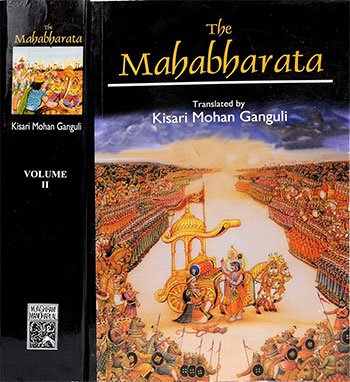Section CXCIX - Dhritarashtra's sorrow over Drona's insult and Satyaki's wrath
Book index: Mahabharata (English)
This page contains a summary of the Mahabharata Section CXCIX including examples of moral lessons in daily life. The Maha-Bharata is one of the largest epics ever written containing roughly 100,000 Sanskrit verses. It deals with the legendary history of ancient India and contains a large number of interwoven tales.
Short summary of the chapter:
The story begins with Dhritarashtra expressing his dismay at the insult suffered by Drona, a highly respected and knowledgeable individual. Satyaki condemns Dhrishtadyumna for his sinful actions and challenges him to battle, but is stopped by Bhima and Sahadeva. Dhrishtadyumna defends his actions, citing the unrighteousness of the Kauravas and the need for revenge. Despite their anger, the Pandavas and their allies emphasize the importance of forgiveness and urge Satyaki to calm down and let go of his wrath.
As Satyaki is restrained by Bhima and Sahadeva, Dhrishtadyumna proposes a one-on-one battle with Satyaki to settle their differences. He expresses his willingness to either defeat Satyaki in combat or be killed by him. The Pandavas and their allies try to mediate the situation and prevent further conflict, emphasizing the importance of unity and forgiveness amongst friends and allies. Dhrishtadyumna is determined to take on the Kauravas in battle and achieve the Pandavas' goal, while Satyaki wrestles with his anger and desire for revenge.
Despite the tense situation and the brewing conflict between Satyaki and Dhrishtadyumna, the Pandavas and their allies succeed in calming the situation and preventing any further escalation of hostilities. Satyaki, although initially consumed by rage, is eventually persuaded to let go of his anger and forgive Dhrishtadyumna. The emphasis on forgiveness, unity, and the greater goal of defeating the Kauravas prevails, leading to a resolution of the conflict between the two warriors. The Pandavas and their allies stand united and focused on their mission.
The story highlights the complexities of loyalty, righteousness, and the challenges of maintaining peace and unity in times of conflict. Satyaki's struggle with his anger and desire for revenge reflects the internal conflicts faced by individuals in the midst of battle. Dhrishtadyumna's determination to fight the Kauravas showcases the unwavering resolve of the Pandavas and their allies in achieving their goal. The theme of forgiveness and the power of unity amidst turmoil emerge as central themes in the story, emphasizing the importance of moral values and collective purpose in times of adversity.
Full English translation:
This page is merely a summary which is automatically generated. If you are looking for authentic sources such as the Sanskrit text or the Full English translation of Mahabharata Section CXCIX - Dhritarashtra's sorrow over Drona's insult and Satyaki's wrath, have a look at the following articles:
Section CXCIX, online text
English translation by Kisari Mohan Ganguli.
Read this and other chapters online.
Mahabharata (English Summary)
by Kisari Mohan Ganguli | ISBN-10: 8121505933
Buy the latest edition:
FAQ of Mahabharata, Section CXCIX:
What led to the conflict between Satyaki and Dhrishtadyumna?
Satyaki was angered by Dhrishtadyumna's harsh words and desired revenge for his actions.
How did Bhima intervene in the situation?
Bhima jumped down from his chariot and restrained Satyaki from attacking Dhrishtadyumna.
How was the conflict between Satyaki and Dhrishtadyumna resolved?
Sahadeva intervened, reminding them of their friendship and the importance of forgiveness.
What actions did the Kshatriyas take after the conflict was resolved?
The Kshatriyas proceeded to battle against the warriors of the hostile army.
Daily life: Dhritarashtra's sorrow over Drona's insult and Satyaki's wrath:
The story eloquently illustrates the destructive nature of unchecked anger and the value of forgiveness and restraint. In daily life, this teaches us the importance of managing our emotions, especially anger, in a constructive manner. Just like Satyaki and Dhrishtadyumna's fiery exchange, escalated tensions can often lead us down a path of regrettable actions if not carefully managed. This narrative serves as a reminder that even in the heat of the moment, taking a step back and assessing the situation calmly can prevent unnecessary conflicts and preserve relationships.
Furthermore, the intervention by Bhima, Sahadeva, Vasudeva, and Yudhishthira highlights how valuable it is to have the support of friends or family who can offer perspective and help us navigate our emotions better. Their efforts to pacify the situation underscore the role that empathy and understanding play in resolving conflicts. Instead of choosing sides, they appealed to the common values and bonds shared among them, showcasing that looking for common ground is often a key step towards reconciliation.
Implementing this in daily life means striving to approach conflicts with patience and seeking to understand the other person's perspective, even when our instincts may push us towards confrontation. It reminds us that forgiveness and dialogue are powerful tools in mending frayed relations. Ultimately, the story teaches us that it is not just the avoidance of conflict that's important, but also how we choose to deal with disagreements when they arise, emphasizing the significance of compassion, wisdom, and the courage to forgive in building lasting relationships.
